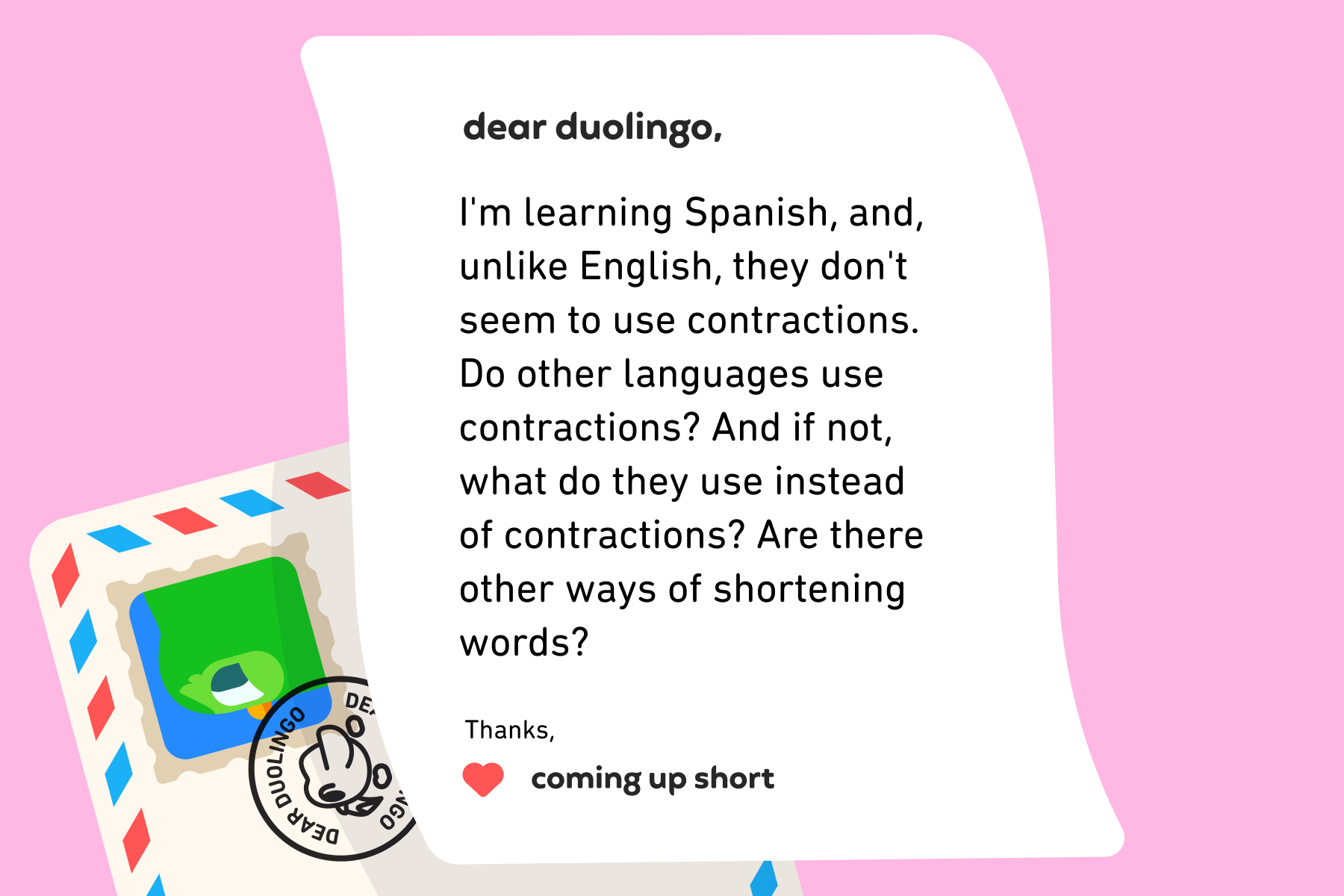Welcome to another week of Dear Duolingo, an advice column just for learners. Catch up on past installments here.
Hey there, learners! To celebrate the days getting longer up here in the Northern Hemisphere, this week's question is about… words getting shorter. Let's take a look!
Our question this week:

Oh, what an interesting observation! In fact, Spanish does have contractions—but they don't use apostrophes, like in English, so they are a little harder to spot. And, as it turns out, one language in particular has contractions like no other. 👀
What are contractions?
Contractions are shortened forms of longer phrases. Languages make contractions in many ways: Some use apostrophes, others push the individual words together and drop a letter or two, and at least one language has special characters for different kinds of contractions.
It's actually not so simple to decide what counts as a contraction. For example, in English, don't (do + not) and can't (can + not) are called contractions, but less formal words like gonna (going + to) and wanna (want + to) aren't. But they could be! Today, these written conventions are still on the newer and more informal side of standard English writing, but in the future they could be considered the same as any old English contraction.
Another challenge is that all spoken and signed language is contracted! Producing language in a sort of "abbreviated" way is natural and necessary—we actually wouldn't be able to understand if someone pronounced everything one letter or sound at a time, so making things flow is the default. What we choose to do in writing is always a less-than-perfect representation of how we actually produce language!
While all languages have guidelines for how to represent casual or short pronunciations in writing, not all of them have these sorts of contractions. So for example, you won't find contractions in Arabic, Chinese, Polish, or Ukrainian.
Here are some contractions you'll find in other languages:
Contractions in Spanish
Spanish has just two contractions: al and del. Notice that Spanish squishes the words together and doesn't use apostrophes.
| Contraction | Combination of | Meaning |
|---|---|---|
| al | a + el | to the (masculine singular) |
| del | de + el | of / from the (masculine singular) |
Contractions in German
German uses apostrophes and combined words, depending on the contraction!
| Contraction | Combination of | Meaning |
|---|---|---|
| fürs | für + das | for the (neuter "the" in nominative and accusative cases) |
| am | an + dem | on / at the (masculine and neuter in the dative case) |
On the other hand, contractions with es (it) use an apostrophe to replace the e-, for example, gibt's is short for gibt es (there is).
Contractions in French
French really takes things to the next level! There are combined words and apostrophes, and plenty of both. Here are a few categories of contractions you can look out for:
Contractions for "the"
In French, there is a special form of "the" that you'll use before words that start with a vowel sound: l' (L + apostrophe). So you'll write l'hôtel (the hotel) and l'orange (the orange), but la grosse orange (the big orange). That's right: This has nothing to do with masculine or feminine—only whether the next word starts with a vowel sound!
Contractions for "it"
There's a second kind of l' you'll encounter: It's a contraction for le ("him, it," masculine) or la ("her, it," feminine), and you'll use it next to verbs that start with a vowel sound. For example, in the present tense, you say Je le vois (I see it / I see him), but some passé composé past tense verbs start with a vowel so you'll use l': Je l'ai vu (I saw it / I saw him).
Contractions for "of" and "from"
Like in Spanish, French uses contractions with the prepositions à (to) and de (of). You'll use d' for de before vowels, as in jus d'orange (orange juice, literally "juice of orange").
These contracted forms have pronunciations quite different from what you'd expect by just pronouncing the two words separately!
| Contraction | Combination of | Meaning |
|---|---|---|
| au | à + le | to the (masculine singular) |
| aux | à + les | to the (plural nouns) |
| du | de + le | of / from the (masculine singular) |
| des | de + les | of / from the (plural nouns) |
Another contraction in this category is auquel (to which)—it's a more advanced word, from à (to) and lequel (which, who), which you learn at the B2 proficiency level.
Contractions in Portuguese
Now that we've covered French, you're warmed up for Portuguese! In Portuguese, you'll find all those forms… and more. 😅 Because the Portuguese articles (words for "the" and "a") all start with vowels, they blend easily into the vowels that come before them.
| Contraction | Combination of | Meaning |
|---|---|---|
| ao | a + o | to the (masculine singular) |
| à | a + a | to the (feminine singular) |
| aos | a + os | to the (masculine plural) |
| às | a + as | to the (feminine plural) |
And look out for aonde, the contraction of à and onde (where), for the word meaning "to where."
| Contraction | Combination of | Meaning |
|---|---|---|
| do | de + o | of / from the (masculine singular) |
| da | de + a | of / from the (feminine singular) |
| dos | de + os | of / from the (masculine plural) |
| das | de + as | of / from the (feminine plural) |
Contractions with em
For em, the preposition meaning "in," there are two sets of contractions: those with the definite articles (the forms of "the"), and another set with the indefinite articles (the forms of "a"). There's some variation regarding the indefinite contractions—and whether they should be written this way or considered contractions at all—but they are common enough that learners might want to recognize them.
| Contraction | Combination of | Meaning |
|---|---|---|
| no | em + o | in the (masculine singular) |
| na | em + a | in the (feminine singular) |
| nos | em + os | in the (masculine plural) |
| nas | em + as | in the (feminine plural) |
| num | em + um | in a (masculine singular) |
| numa | em + uma | in a (feminine singular) |
| nuns | em + uns | in some (masculine plural) |
| numas | em + umas | in some (feminine plural) |
Contraction with não
There's one more Portuguese contraction to know about: né? And that's right—it's a question! You'll hear it as a tag question at the end of sentences as a contraction for não é (it isn't). It's used to check for agreement or understanding, just like we might add isn't it? in English.
The most interesting contractions: Thai
I first learned about Thai contractions from our post about the sounds animals make in different languages—and so I had Thai translation expert Anupong Nuekaew tell me all about it! To keep written Thai succinct, Thai uses different characters for contractions, sort of like how the apostrophe in English means "Hey, there's a sound or letter missing here!" But in Thai, there are characters for different situations!
Contraction for repetition
The first Thai contraction character is ๆ, and it's used when a word is repeated—instead of writing it out again, you use ๆ. So the sound that dogs make in Thai is โฮ่ง (hong), repeated twice (hong hong), and you write it with โฮ่ง (for "hong") and then ๆ to show it's not just one hong… it's two: โฮ่งๆ (hong hong).
Contraction when the vibe is right
There is another contraction character in Thai, the omission character ฯ. This is what's written in a long phrase that you really don't need to read all of to understand. For example, สหรัฐอเมริกา (sa-ha-rat-america) is the complete name for the United States of America, but you can write สหรัฐ (sa-ha-rat) + ฯ to show that the rest of it was omitted—but you know the reader will know what you're referring to! This character is especially important in the shortened form of the Thai name for Bangkok, กรุงเทพฯ… because the city's full name is 176 characters!
Languages all take short cuts
What all these contractions have in common is that they are ways we try to make our written language better represent how we speak—whether that's because our words naturally flow together, or because our writing conventions lag behind how we use language, or just because we want to write faster!
For more answers to your language and punctuation questions, get in touch with us by emailing dearduolingo@duolingo.com.
